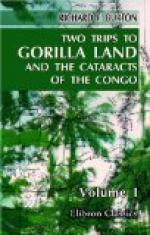The native villages, exactly resembling those of the Gaboon, are all built near the strip of fine white sand which forms the shore, and upon the sweet water channels which cut deep into the limestones. They are infested with rats, against whose depredations the mango trees must be protected with tin ruffs; yet there are six kinds of reptilia upon the island, including the common black snake and cobras, from six to seven feet long: these animals, aided by the dogs, which also persecute the iguanas, have prevented rabbits breeding. In Barbot’s time (1700) there were only thirty or forty inhabitants, who held the north-eastern point about a league from the wooding and watering places. “That handful of blacks has much ado to live healthy, the air being very intemperate and unwholesome; they are governed by a chief, who is lord of the island, and they all live very poorly, but have plenty enough of cucumbers, which grow there in perfection, and many sorts of fowl.” In 1856 the Rev. Mr. Wilson reckons them at less than 2,000, and in 1862 I was told that there were about 1,100, of whom 600 were Bengas. In look, dress, and ornaments they resemble the Mpongwe, but some of them have adopted the Kru stripe, holding a blue nose to be a sign of freedom. They consider themselves superior to the “Pongos,” and they have exchanged their former fighting reputation for that of peaceful traders to the mainland and to the rivers Muni and Mundah. They live well, eating flesh or fish once a day, not on Sundays only, the ambition of Henri Quatre: at times they trap fine green turtle in seines, but they do not turn these “delicate monsters.”
Mr. Wilson numbered the whole Benga tribe at 8,000, but Mr. Mackey reduced the figure to half. Besides Corisco they inhabit the two capes at the north and south of the bay. The language is used by other tribes holding the coast northward for a hundred miles or more, and probably by the inner people extending in a northerly direction from Corisco Bay: the same, with certain modifications, is also spoken at Sao Bento, Batanga, and perhaps as far north as the Camarones River. On the other hand, the tribes occupying the eastern margin of Corisco Bay, such as the Mbiko, Dibwe, and Belengi, cannot understand one another, and the tongues of the southward regions differ even more from the Benga. Yet all evidently belong to the great South African family.
Mr. Mackey, who explored Corisco Island in 1849, assures us that scarcely any of the older inhabitants were born there; they came from the continent north or north-east of the bay, gradually forcing their way down. The characteristic difference of the Benga, the Bakele, and the Mpongwe dialects is as follows: “The Mpongwes have a great partiality for the use of the passive voice, and avoid the active when the passive can be used. The Bakele verb delights in the active voice, and will avoid the passive even by a considerable circumlocution. The Benga takes an intermediate position in this respect, and uses the active and passive very much as we do in English.”




